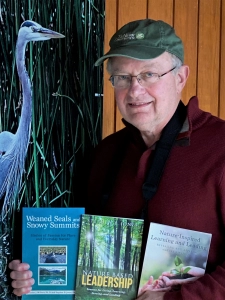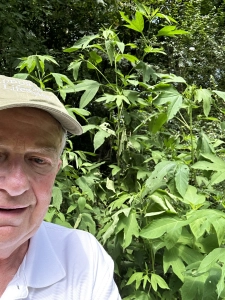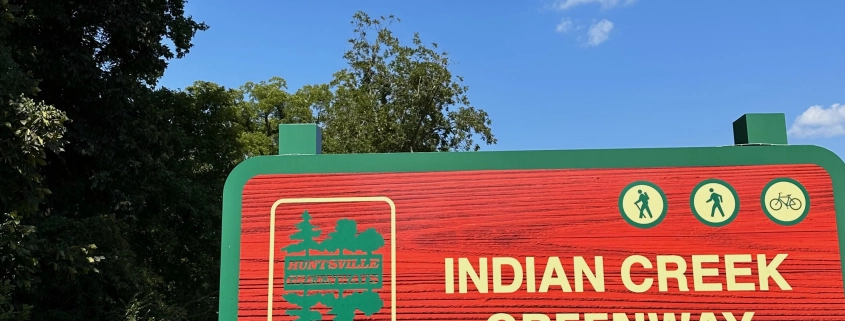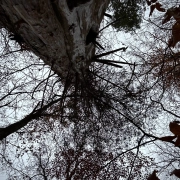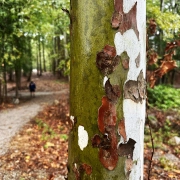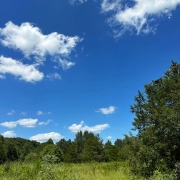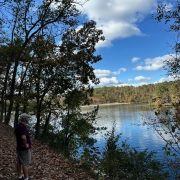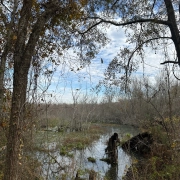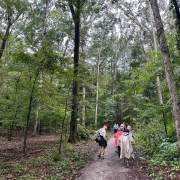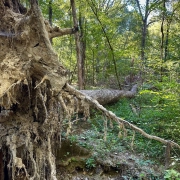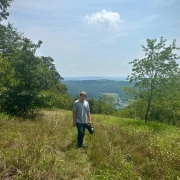An August Afternoon Stroll along Indian Creek Greenway!
On Friday, August 9, 2024, I stopped by Huntsville, Alabama’s Indian Creek Greenway to trek a couple of miles to capture images of mid-summer flowers, trees, seasonal breezes, and the mood of Indian Creek in the late afternoon shade. I wanted to inhale Nature’s summer essence before my total right knee replacement on August 20. I had my left knee replaced on January 23, 2024. I know what to expect. I will be out of my woodland sauntering mode until mid-October when I hope to be on track for the kind of mobility I’ve missed for years! [Note: I’m putting the final touches on this photo essay just a couple of hours after hiking (slowly and cautiously) the one-half-mile Rainbolt Trail on the Rainbow Mountain Nature Preserve in Madison, Alabama on October 13, 2024!]
I entered the greenway at 2:30 PM and enjoyed a drier airmass and lower temperatures. There was no need to deal with the more typical hot, hazy, and humid days of mid-August!
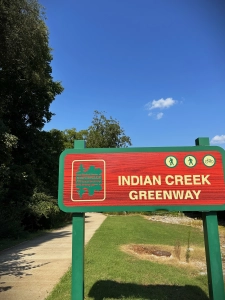
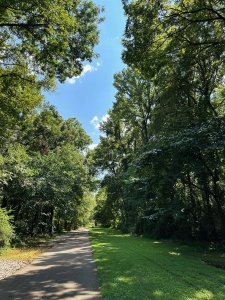
Like so many of our greenways, this one occupies a sewer line right-of-way running through an active flood plain, the overflow triggered several times a year by drenching thunderstorms and prolonged winter and spring rains. The stream ran at a routine summertime flow as I walked along the trail and occasionally penetrated to creekside. I’ll report on my creek-proximate wanderings in a complementary photo essay.
I recorded this 59-second video a few hundred yards from the southern end of the greenway. I began the video with a magnificent green ash tree rising from the forest edge. I remind readers that these urban flood plains are naturally fertile with deep soils routinely refreshed with sediment- and nutrient-laden flood waters. The ash and other riparian forest neighbors express site quality with their height, this ash reaching at least 100 feet above the forest floor.
Here is a still photograph of the subject green ash tree. Well, I must admit that this a screen shot from the video. At the top edge of the photo, leaning in from the opposite greenway edge, a black walnut crown is attempting to close the aerial tunnel over the pedestrian and biking path.
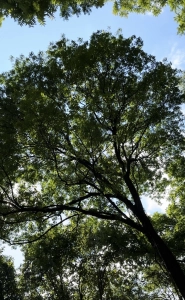
When an old forester (BS in Forestry, 1973) seeks a woodland saunter as he returns home from an OLLI UAH Board meeting, can anyone deny him the joy of focusing a video or two on special trees! I found the mostly sunny skies mesmerizing above the greenway and its trailside forests. This time, I centered the 57-second video around a large shagbark hickory.
There are things I cannot resist, of which one is the complex bark of shagbark hickory, which like the song of a Carolina chickadee says its name.
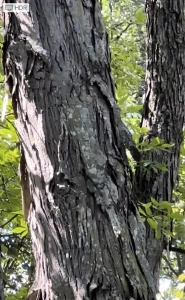
I am a relentless fan of the writings of Aldo Leopold, America’s consummate conservationist and father of North American wildlife biology. He observed:
Our ability to perceive quality in nature begins, as in art, with the pretty. It expands through successive stages of the beautiful to values as yet uncaptured by language.
Shagbark hickory is a work of art, a consequence of timeless evolution. It’s the only tree of our southern hardwood forests with overlapping plated bark. To what advantage evolutionarily, I ponder? I’ve heard that various woodland bats find shelter under the plates. Do the bats deter foliar-consuming insects, or gobble stem-boring weevils or nut pests? I don’t know the answer, nor did a quick internet query yield an explanation. Leonardo da Vinci may be one of the top five scientific minds of the past 1,000 years. I base my observation that the tree’s bark owes its peculiar nature to evolution on a simple da Vinci quote:
There is no result in nature without a cause; understand the cause and you will have no need of the experiment.
Those in local, state, regional, and national circles of Nature enthusiasts often lament of a species that it is an alien, an invasive, a pest, and other derogatory monikers. Chinese yam is one such interloper growing in profusion at this section of the greenway edge.
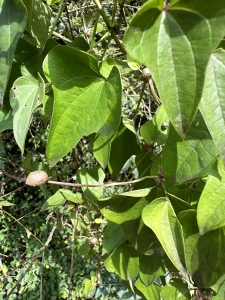
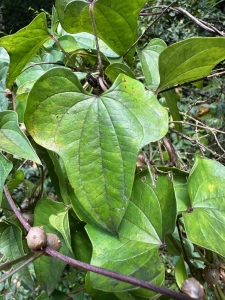
An NC State Cooperative Extension online source stated:
Chinese Yam was introduced here as early as the 19th century for culinary and cultural uses and is now considered an invasive plant species in several states. It has spread from Louisiana to Vermont and can form dense masses of vines that cover and kill native vegetation, including trees, within a variety of moist, disturbed habitats. It spreads by seed, tubers and by the small tubers in leaf axils.
I marveled at the small branch tubers, recalling that they are edible. While I do abhor widespread, truly invasive ecosystem-threatening alien plants like Chinese privet and kudzu, I do not get exorcised by Chinese yam. Instead I shall view it as Earth-native and not particularly worthy of calling out the National Guard.
I recorded this 57-second Chinese yam video:
Here is a screenshot of two leaf axil tubers.
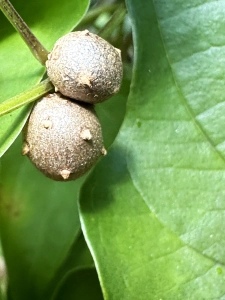
Giant ragweed is an impressive plant native. The cluster below has already reached eight feet. An online source spoke of it in ways seeming unkind:
This is an annual herb usually growing up to 2 m (6 ft 7 in) tall, but known to reach over 6 m (20 ft) in rich, moist soils. The tough stems have woody bases and are branching or unbranched. Most leaves are oppositely arranged. The blades are variable in shape, sometimes palmate with five lobes, and often with toothed edges. The largest can be over 25 cm (9.8 in) long by 20 cm (7.9 in) wide. They are borne on petioles several centimeters long. They are glandular and rough in texture.
Ragweed pollen is a common offensive allergen. The plant is a serious agricultural nuisance and a tough weed to control. That it is a native doesn’t make the farmer dealing with it more accepting nor less aggravated.
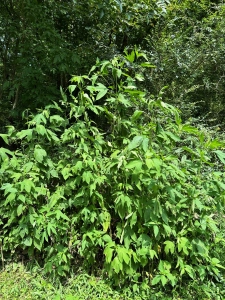
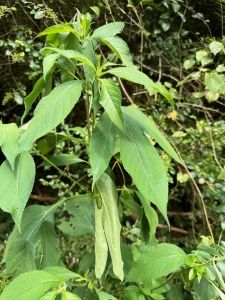
I’ve been a lifetime proponent of spring ephemeral wildflowers, the woodland beauties that populate the forest floor between the onset of warming days and full leaf-out within the forest canopy. Retirement has enabled me to spend more time appreciating the summer wildflowers that seem happiest along forest edge habitat. Wingstem greeted me along the greenway.
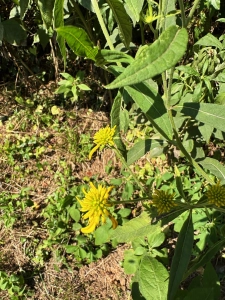
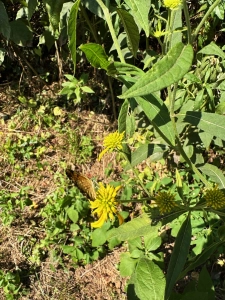
A silvery checkerspot butterfly appreciated the wingstem for reasons other than aesthetic.

Ironweed is a summer perennial member of the aster family. I see it commonly on forest edges. I never tire of its rich color.
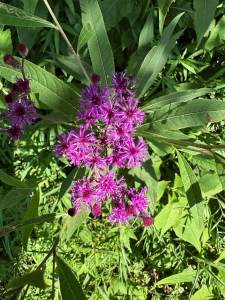
I recorded this 34-second video of another common forest edge woody species, osage orange. Maclura pomifera bears many common names, among them: mock orange, hedge apple, bow wood, horse apple, monkey ball, monkey brains, and yellow-wood.
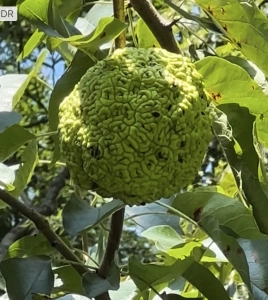
European settlers found that a perimeter of osage orange stakes would self-sprout quickly into a dense fence-tangle of growth effective at protecting vegetable gardens and crops from marauding domestic grazers and foraging wildlife. Native Americans prized the wood for bow-making. I urge readers to dig more deeply into web sources to learn more about this curious and valuable small tree or shrub.
Osage orange is a member of the mulberry family. I recorded this 45-second video of our native red mulberry not far from the osage orange:
European settlers arriving along the Virginia coast in 1607 enthusiastically mentioned the abundance of mulberry, common from Florida to Ontario and west to the plains. Birds consume the sweet fruit and distribute the scarified seeds, which establish readily along edges and across meadows.
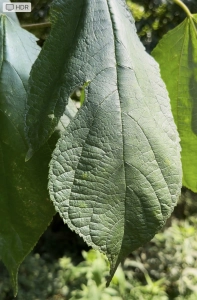
Here is my brief red mulberry video:
Black walnut prefers rich well-drained sites along streams like Indian Creek. This cluster of three hefty nuts portends a good walnut crop. Unlike the largely inedible osage orange fruits, many wildlife species lust for big meaty walnuts.
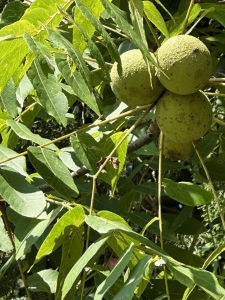
River birch’s moniker does more than hint at its preferred creek and riverside growing sites. I like its pendulant branching and exfoliating bark enough that we planted a three-stemmed specimen in our backyard. Our irrigation system meets its requirement for ample soil moisture even in periodic dry stretches.
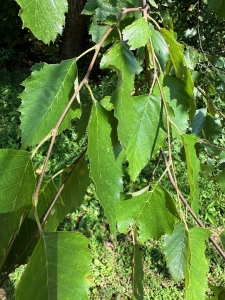
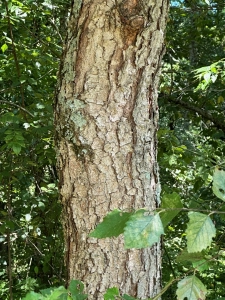
I could not resist recording another short video of the greenway, its meadow corridor, the stunning sky, and the narrow forest edge, and a rough path heading to creekside.
Here is the 59-second video that transitions from the greenway through a narrow border forest to creekside:
Note the “candy cane” sewer line ventilation pipe along the greenway.
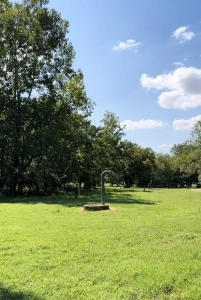
Were I not scheduled for knee surgery 11 days hence, I may have suppressed my videographic eagerness. However, each is brief and every one offers a unique emphasis. I recorded this 57-second video near my turn-around point at 3:02 PM, focusing on the brilliant sunshine and afternoon breeze (listen to it!), and including a short transit across the forest border to the shore of Indian Creek.
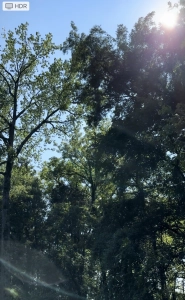
I’ll use this same video to begin my subsequent photo essay highlighting Indian Creek!
Thoughts and Reflections
I offer these observations:
- There is no result in nature without a cause; understand the cause and you will have no need of the experiment. (Leonardo da Vinci)
- Oh, how insulting to something as beautiful as ironweed to include “weed” in its name!
- An urban greenway (along a sewer right-of-way) just 4.5 miles from my home supplies an endless stock of Nature’s fine elixir!
Inhale and absorb Nature’s elixir. May Nature Inspire, Inform, and Reward you!
Note: Unless otherwise noted, all blog post images are created & photographed by Stephen B. Jones. Please circulate images with photo credit: “©2024 Steve Jones, Great Blue Heron LLC. All Rights Reserved.”
Another Note: If you came to this post via a Facebook posting or by another route, please sign up now (no cost… no obligation) to receive my Blog Post email alerts: http://eepurl.com/cKLJdL
And Third: I am available for Nature-Inspired Speaking, Writing, and Consulting — contact me at steve.jones.0524@gmail.com
A reminder of my Personal and Professional Purpose, Passion, and Cause
If only more of us viewed our precious environment through the filters I employ. If only my mission and vision could be multiplied by untold orders of magnitude:
Mission: Employ writing and speaking to educate, inspire, and enable readers and listeners to understand, appreciate, and enjoy Nature… and accept and practice Earth Stewardship.
Vision:
- People of all ages will pay greater attention to and engage more regularly with Nature… and will accept and practice informed and responsible Earth Stewardship.
- They will see their relationship to our natural world with new eyes… and understand their Earth home more clearly.
Tagline/Motto: Steve (Great Blue Heron) encourages and seeks a better tomorrow through Nature-Inspired Living!
Steve’s Four Books
I wrote my books Nature Based Leadership (2016), Nature-Inspired Learning and Leading (2017), Weaned Seals and Snowy Summits: Stories of Passion for Place and Everyday Nature (2019; co-authored with Dr. Jennifer Wilhoit), and Dutton Land & Cattle: A Land Legacy Story (2023) to encourage all citizens to recognize and appreciate that every lesson for living, learning, serving, and leading is either written indelibly in or is powerfully inspired by Nature. All four of my books present compilations of personal experiences expressing my deep passion for Nature. All four books offer observations and reflections on my relationship with the natural world… and the broader implications for society. Order any from your local indie bookstore, or find them on IndieBound or other online sources such as Amazon and LifeRich.
I began writing books and Posts for several reasons:
- I love hiking and exploring Nature
- I see images I want to (and do) capture with my trusty iPhone camera
- I enjoy explaining those images — an educator at heart
- I don’t play golf!
- I do love writing — it’s the hobby I never needed when my career consumed me
- Judy suggested my writing is in large measure my legacy to our two kids, our five grandkids, and all the unborn generations beyond
- And finally, perhaps my books and Blogs could reach beyond family and touch a few other lives… sow some seeds for the future
